| |
Standard Colors
To appear on the registration form |
1. White
Pure white as a unique color does not actually exist in dogs.
Whites may be either extremely
paled out cream or paled out gold selfs, or
they may be spotted dogs with great color
restriction.
|
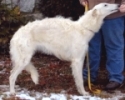 |
2.Cream
Creams are born silver-grey and then loose the grey color as they grow, usually it is gone by 12 weeks of age.
|


|
3.Gold
Gold dogs are born gold and do not significantly darken with age.
Because gold is due to a gene that prevents black hairs from appearing in the coat, gold dogs can be genetically black, black and tan
or black and brindle. |
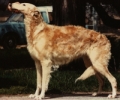
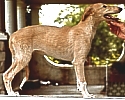

|
4 .Red
In Borzoi Red will be used for dogs with intense pheomelanin,
the red pigment. If dark hairs are present in the coat, they will be black,
not liver. Nose and eye-rim pigment, where present, will be black, not
liver colored. Red will not be used for dogs that are
brown dilution coat color. These dogs have liver nose leather and
eye rim pigmentation. Brindle, sable, black mask and other terms that apply
to different patterns of black hairs dispersed through the coats of reds.
|
 |
5. Black
Black without lightening of the extremities is a genetically different color than the
black accompanied by lighter shades on the extremities, the latter is called
Black and Tan or Cream in this document. In some cases Black and Brindle dogs
may be difficult to distinguish from Black dogs. In the picture on the right the
black and tan dog has a black mask.
| 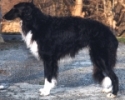 |
6. Black and tan
is the term applied to black dogs with a distinctive pattern of light points. Note the zig-zag marking
on the cheek and the way the tan runs up the front of the hind legs and how it forms a butterfly pattern on ]
the chest, across the base of the neck and the front of the shoulders. Black and tan dogs that do not possess black mask will also have distinctive tan spots above the
eyes. Black and tan pups appear almost solid black at birth but the tan points appear within a few days to
a few weeks.
|


|
7. Black & cream
occurs when the black and tan pattern is present in a dog in which the red pigmented is paled out to cream.
|
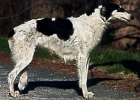
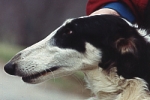
Although the tan is paled to such a pale cream that it may seem white, the distinctive cheek pattern
seen in black and tan is still visible in these dogs.
|
8. Black & brindle
is the color term applied to a black and tan patterned dog in which
the brindle pattern gene is also present so that the tan portions of the
dog are brindled.
In the right hand picture there is a comparison of the leg markings in a black and brindle (on left) to a
black and tan (on right). Sometimes the brindle is so intense it is difficult to recognize that the
dog is a brindle rather than a self black.
|
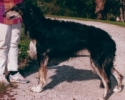

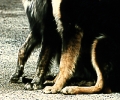
|
9.Brindle
is the term applied to a pattern of black stripes and stripples that occur where ever red is present in the coat.
Brindle dogs are brindled at birth although they may look darker than they will be as adults. Classically Brindle is used to
describe the color that might be called grey brindle or cream brindle. That is a brindle with an undercoat that is cream. If the stripes are
extensive the dog appears to be a grey brindle while if they are sparse it has a cream base color Because this is the traditional use
of the pattern/color name Brindle there is no need for a separate pattern/color name Cream brindle.
| 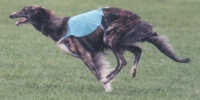
Steve Surfman photo |
10. Silver brindle
is the pattern and color combination that occurs when a cream dog has brindle markings. |  |
11. Gold brindle
This would not be a possible color if we restrict the use of Gold to extension locus yellow dogs which cannot have
black in their coat.
|  |
12. Red brindle
is the pattern and color combination that occurs when a red dog has brindle markings. |  |
13. Sable
Is a pattern with light points that are more extensive than in Black and tan (of which it may be a special case)
in which the points are pale and the upper body is dark because the hairs are tipped with dark pigment and pale at the base. Sables have never been seen with
black masks. Sable Borzoi are dark at birth but have their distinctive markings by 4 weeks of age (left and center pictures). This dog has a small white marking in
the middle of his forehead. The picture on the rightt is a front view showing thr distinctive "windows peak" and the lack of black
color immediately around the eyes. In some cases adult Sables and adult sabled reds can be difficult to distinguish from each other
but the pattern of development of the colors from birth is distinct. It is not nearly as difficult to
distinguish sable puppies from sabled red puppies.
|
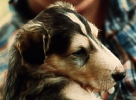
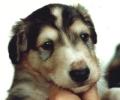

|
14. Silver sable
are sables in which all the red is faded to pale cream.
|
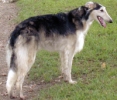
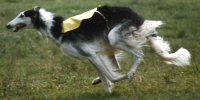
Photo credit, first photo on left Patti Neale
|
15. Gold sable
is used to describe sable dogs in which the undercolor is intermediate between cream and red. It is not a reference to
the extension yellow golds.
|

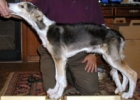

Photo credit Patti Neale |
| 16.Brindled sable
patterned dogs have brindle where the coat is not heavily marked with black. If a Brindle sable dog is clipped to the
skin however, brindle stripes can also be seen on the back and neck. The presence of the sabled hair tips in the dark areas obscures
the brindled pattern but where brindle stripes are present on the back and upper neck, the hairs are dark to the skin rather than
just being tipped with black.
|

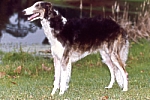
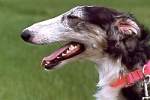
Photo credit (2nd & 3rd dog) Patti Neale |
17. Sabled gold
This would not be a possible color if we restrict the use of Gold to extension locus yellow dogs which cannot have
black in their coat.
|  |
18. Sabled red
is used to describe Red dogs in which the coat has an overlay of black hairs. These dogs are rather brown at birth
and lighten as they approach puberty. The black overlay develops at or shortly after puberty and becomes more intense with each
subsequent shed and regrowth cycle. Individuals carrying the tan point (at) gene can show stiking contrasts
of the light face to dark forehead (see dog on right). While adult sables and sabled reds can be hard
to distinguish, what is difficult in red puppies is identifying the sabled reds
as pups, they may show little indication of the dark colors they will display when fully mature.
|
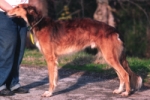
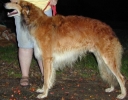
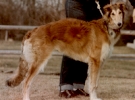
|
Standard Markings
To appear on the AKC registration form.
The combinations shown are examples only. All standard colors and alternate
colors may be combined with the markings if a dog possesses them. |
|
Cream or Gold | Red | Black, Black and Tan, Black and Cream, Black and Brindle | Sables | Brindles | Silver and other colors |
1. Spotted on white
White markings from extreme white spotting through 50% of the dog with white. |
Cream or apricot or gold spotted on white |
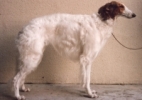
Red spotted on white
|
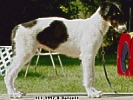
Black and Tan spotted on white
|
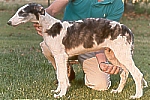
Sable brindle spotted on white. Photo credit Patti Neale |
Brindle spotted on white | Silver and other colors spotted on white |
2. white markings
White markings over 49& of the dog down to white markings with a neck ring.
|
Cream or Gold, white markings | Red, white markings |
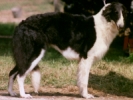
Black, white markings |
Sable, white markings | Brindle, white markings | Silver and other colors, white markings |
3. White trim
White on the legs, chest, belly, tail tip, and a blaze to white on the toes and chest only. |
Cream or Gold, white markings | Red, white trim |

Black, white trim |
Sable, white trim | Brindle, white trim | Silver and other colors, white trim |
4. Black mask
Genetically called superextension, this is a dark marking which may be limited to the muzzle or may extend to the back of the head. There are various degrees. The ears are black rimmed and black may occur on the chest and on the front of the feet.
|
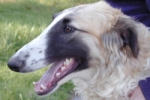

Cream, black mask.
(Golds - which lack black in the coat, cannot have a black mask.) This dog also
has white markings. However black masked creams are very rare so I used him in this example.
|
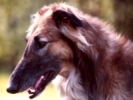
Red, black mask. |

Black and tan , black mask. Black and cream and Black and brindle dogs can also have a black mask. Black only dogs cannot show a black mask. |
Sables have never been seen with a black mask. Write the color committee with pictures if you
have an example, please |
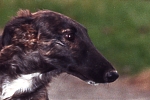
Brindle, black mask |
Silvers have not been seen with a black mask. Write the color committee with pictures if you
have an example, please |
5. Spotted on white, black mask
|
Cream spotted on white, black mask. Golds - which lack black in the coat, cannot have a black mask. |

Red spotted on white, black mask |
Black and tan spotted on white , black mask.
If the Black Mask is extensive
as shown in the picture, the distinctive
eye-spots can be obscured.
Black and cream dogs can have a black mask.
Black only dogs cannot show a black mask.
|
Sables have never been seen with a black mask. Write the color committee with pictures if you
have an example, please | Brindle spotted on white, black mask |
Silvers have not been seen with a black mask. Write the color committee with pictures if you
have an example, please |
6.White markings, black mask
|
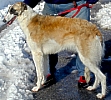
Fawn, white markings, black mask |
Red white markings, black mask |
Black and tan white markings , black mask. Black and cream dogs can have a black mask. Black only dogs cannot show a black mask. |
Sables have never been seen with a black mask. Write the color committee with pictures if you
have an example, please |
Brindle white markings, black mask |
Sables have not been seen with a black mask. Write the color committee with pictures if you
have an example, please |
7. White trim, black mask
|
Cream or fawn, white trim black mask  |
Red white trim black mask |
Black and tan white trim, black mask. Black and cream dogs can have a black mask. Black only dogs cannot show a black mask. |
Sables have never been seen with a black mask. Write the color committee with pictures if you
have an example, please | Brindle spotted on white, black mask |
Silvers have not been seen with a black mask. Write the color committee with pictures if you
have an example, please |
8. Spotted on white,ticked
Ticking is the presence of small, usually oval, color spots of the base coat color, in the areas where a white marked dog is white. Ticking is rarely present at birth and may not become evident until the dog is past puberty. It becomes more intense with age
|
Cream or fawn, spotted on white, ticked  |
Red or apricot, spotted on white, ticked |
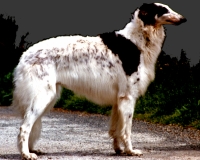 Black and Cream spotted on white, ticked .
Black and Cream spotted on white, ticked . |
Sable brindle spotted on white, ticked |
Brindle spotted on white, ticked |
Silver spotted on white, ticked |
9. White markings, ticked
|
Cream or fawn, white markings, ticked |
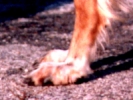
Red, white markings, ticked |
Black, Black and Tan, Black and Cream, white markings, ticked |
Sable, white markings, ticked |
Brindle, white markings, ticked |
Silver, white markings, ticked |
Alternate Colors
The alternate colors will appear on the AKC website and a list of same will
be provided to registrants upon request.
|
Alt 1.
fawn
Borzoi have more intense red in the coat than creams, black tipped hairs are interspersed into the coat but do not produce a heavy sabled overlay.
This dog is a black masked fawn. | 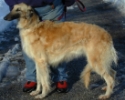 |
Alt 2. Apricot
Apricots have more intense red than golds, they lack black hairs in the coat. They are ee golds with red intensifiers. | 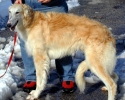 |
Alt 3. Blue
The recessive blue dilution gene dd, changes all black pigement in the coat to maltese blue.
On the left, a blue dilute sabled red.
The left center picture shows new born puppies, a blue dilute on black compared to a non-dilute black littermate.
The right center picture shows the "sky-blue" eye seen in some young blue dilute pups.
By adulthood this changes to "paper-bag brown" or hazel, right picture. |
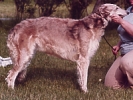
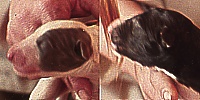

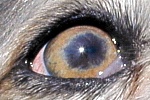 |
Alt 4. Blue & cream
Blue and cream occurs when a black and tan or black and cream (atat) dog has two copies of the blue dilute gene. |
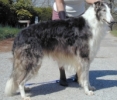 |
Alt 5. Silver
Silver is the color name applied to Borzoi with a mixture of gray and black hairs on the face and legs. The body will have long dark hairs that may be tipped with light colors. The face is not paled out as it is in a sable and the fronts of the lower fore legs are darker than the feathering along the backs of the legs. | 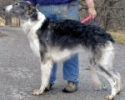 |
Alt 6. Mahogany brindle
Mahogany brindle is the name of the color when a brindle dog is so heavily striped that the distinct striping is difficult to see. | 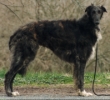 |
Alt 7. Blue brindle
A brindle dog with two doses of the dd dilution gene. | 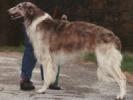 |
Alt 8. Cream sable
If in parallel to brindle we consider the default sable to be a cream sable, then we do not need this category. |  |
Alt 9. Red sable
A sable dog in with intense red in the areas without black hairs. |
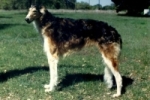

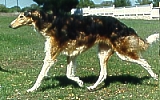
This color is rare. Pictures © courtesy of Francie Stull, used with permission.
|
Alt 10. Sabled cream
The same distribution of black hairs as a sabled red dog but with paling of the red pigment. | 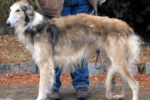 |
Alt 11. Mahogany red
An intensly darkened sabled red. |
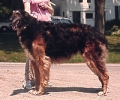
Although born dark this dog was bright red at a year of age.
Picture courtesy of Louenna Avery, Kostenov Borzoi, used with permission.
|
Alt 12. Brown
This color is the brown (liver) dilute. All black pigment is changed to
liver brown. It is rare in Borzoi but occurs. I had to manipulate the color of
the photo to produce a liver dilute effect in this picture.
|


|













































 Black and Cream spotted on white, ticked .
Black and Cream spotted on white, ticked . 















